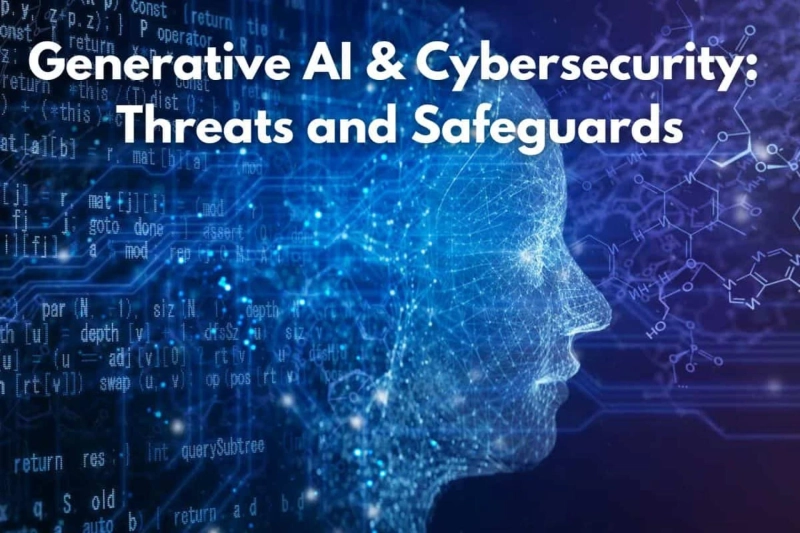In the ever-evolving landscape of cybersecurity, the integration of Generative Artificial Intelligence (Generative AI) introduces both opportunities and challenges. As organizations harness the power of AI for enhanced threat detection and response, the same technology can be exploited by malicious actors to create sophisticated attacks. This exploration delves into the dual role of Generative AI in cybersecurity, examining the potential threats it poses and the safeguards required to secure our digital ecosystems.
Threats Posed by Generative AI:
Automated Cyber Attacks: Generative AI has the potential to automate cyber attacks at an unprecedented scale. Malicious actors can leverage AI-generated tools to conduct phishing campaigns, craft convincing social engineering messages, or automate the exploitation of vulnerabilities in systems. The speed and efficiency of AI-driven attacks pose a significant threat to traditional cybersecurity defenses.
Adversarial Attacks: Generative AI models, when manipulated by adversarial actors, can generate subtle variations in data that may deceive other AI systems. Adversarial attacks target the vulnerabilities in machine learning models, leading to misclassifications and compromise of security measures. This cat-and-mouse game between Generative AI and cybersecurity measures requires constant vigilance and adaptation.
Deepfake Threats: The rise of deepfake technology, a form of Generative AI, introduces new dimensions to cybersecurity threats. Deepfakes can convincingly manipulate audio and video content, creating deceptive narratives or impersonating legitimate individuals. In the realm of cybersecurity, this poses risks of spreading misinformation, conducting phishing attacks, or undermining trust in digital communication.
Safeguards and Defensive Strategies:
AI-Powered Threat Detection: To counter the threats posed by Generative AI, organizations must embrace AI-driven threat detection solutions. These systems leverage machine learning algorithms to analyze patterns, detect anomalies, and identify potential cyber threats. Implementing advanced AI-powered intrusion detection systems becomes crucial in staying one step ahead of evolving cyber threats.
Adversarial Training for AI Models: Proactively addressing adversarial attacks involves training AI models to recognize and resist manipulated inputs. Adversarial training, where models are exposed to adversarial examples during the training phase, helps fortify them against potential attacks. This approach enhances the resilience of AI systems, making them more robust in the face of evolving adversarial techniques.
Behavioral Analysis and Anomaly Detection: Employing behavioral analysis and anomaly detection techniques becomes essential in a cybersecurity strategy. By monitoring user behavior and network activities, organizations can identify deviations from normal patterns that may indicate a cyber threat. Generative AI-powered tools can assist in analyzing vast datasets to discern patterns and detect anomalies indicative of potential attacks.
Verification Mechanisms for Multimedia Content: In combating deepfake threats, implementing robust verification mechanisms for multimedia content is imperative. Blockchain technology, with its decentralized and tamper-evident nature, can be employed to verify the authenticity of digital media. Integrating cryptographic signatures and metadata verification ensures that multimedia content remains trustworthy and untampered.
Ethical Use of Generative AI: Promoting ethical practices in the development and deployment of Generative AI is a foundational safeguard. Organizations must adhere to ethical guidelines, ensuring that AI technologies are used responsibly and with a commitment to protecting privacy and security. Establishing ethical frameworks for the use of Generative AI contributes to building a secure and trustworthy digital environment.
Conclusion: Navigating the Generative AI Cybersecurity Landscape
As Generative AI continues to advance, the cybersecurity landscape faces a dual challenge of harnessing its benefits while mitigating potential threats. The synergy between Generative AI and cybersecurity safeguards requires a holistic approach, incorporating advanced threat detection, proactive adversarial training, behavioral analysis, and ethical considerations. By staying vigilant, adopting cutting-edge defensive strategies, and fostering ethical practices, organizations can navigate the evolving landscape of Generative AI in cybersecurity, ensuring a secure and resilient digital future.


